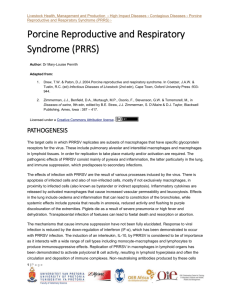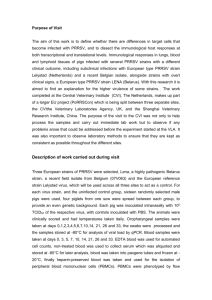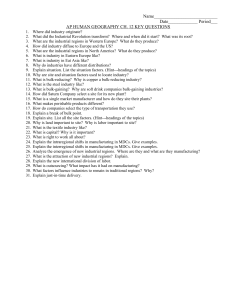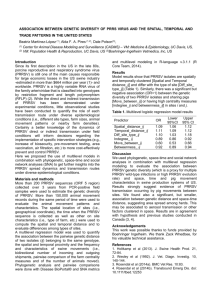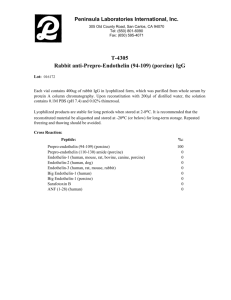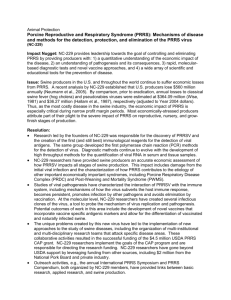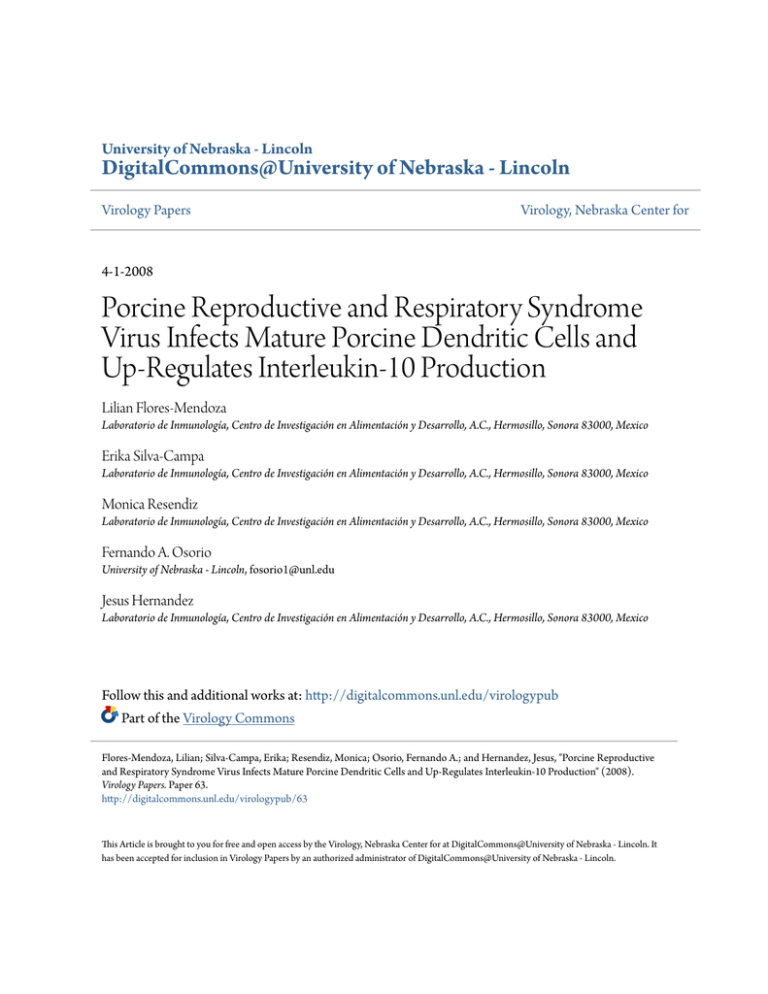
University of Nebraska - Lincoln
DigitalCommons@University of Nebraska - Lincoln
Virology Papers
Virology, Nebraska Center for
4-1-2008
Porcine Reproductive and Respiratory Syndrome
Virus Infects Mature Porcine Dendritic Cells and
Up-Regulates Interleukin-10 Production
Lilian Flores-Mendoza
Laboratorio de Inmunología, Centro de Investigación en Alimentación y Desarrollo, A.C., Hermosillo, Sonora 83000, Mexico
Erika Silva-Campa
Laboratorio de Inmunología, Centro de Investigación en Alimentación y Desarrollo, A.C., Hermosillo, Sonora 83000, Mexico
Monica Resendiz
Laboratorio de Inmunología, Centro de Investigación en Alimentación y Desarrollo, A.C., Hermosillo, Sonora 83000, Mexico
Fernando A. Osorio
University of Nebraska - Lincoln, fosorio1@unl.edu
Jesus Hernandez
Laboratorio de Inmunología, Centro de Investigación en Alimentación y Desarrollo, A.C., Hermosillo, Sonora 83000, Mexico
Follow this and additional works at: http://digitalcommons.unl.edu/virologypub
Part of the Virology Commons
Flores-Mendoza, Lilian; Silva-Campa, Erika; Resendiz, Monica; Osorio, Fernando A.; and Hernandez, Jesus, "Porcine Reproductive
and Respiratory Syndrome Virus Infects Mature Porcine Dendritic Cells and Up-Regulates Interleukin-10 Production" (2008).
Virology Papers. Paper 63.
http://digitalcommons.unl.edu/virologypub/63
This Article is brought to you for free and open access by the Virology, Nebraska Center for at DigitalCommons@University of Nebraska - Lincoln. It
has been accepted for inclusion in Virology Papers by an authorized administrator of DigitalCommons@University of Nebraska - Lincoln.
CLINICAL AND VACCINE IMMUNOLOGY, Apr. 2008, p. 720–725
1556-6811/08/$08.00⫹0 doi:10.1128/CVI.00224-07
Copyright © 2008, American Society for Microbiology. All Rights Reserved.
Vol. 15, No. 4
Porcine Reproductive and Respiratory Syndrome Virus Infects Mature
Porcine Dendritic Cells and Up-Regulates Interleukin-10 Production䌤
Lilian Flores-Mendoza,1 Erika Silva-Campa,1 Mónica Reséndiz,1
Fernando A. Osorio,2 and Jesús Hernández1*
Laboratorio de Inmunologı́a, Centro de Investigación en Alimentación y Desarrollo, A.C., Hermosillo, Sonora 83000, Mexico,1 and
Department of Veterinary and Biomedical Sciences, University of Nebraska—Lincoln, Lincoln, Nebraska 68583-09052
Received 1 June 2007/Returned for modification 8 September 2007/Accepted 1 February 2008
Porcine reproductive and respiratory syndrome virus (PRRSV) infects mature dendritic cells (mDCs)
derived from porcine monocytes and matured with lipopolysaccharide. The infection of mDCs induced apoptosis, reduced the expression of CD80/86 and major histocompatibility complex class II molecules, and
increased the expression of interleukin-10, thus suggesting that such mDC modulation results in the impairment of T-cell activation.
(74-22-15); and for CD14, CAM36A; all were from VMRD
(Pullman, WA). Other key reagents included mouse immunoglobulin G (IgG) Fc-human cytotoxic T-lymphocyte-associated
antigen 4 fusion protein (501-820; Ancell, Bayport, MN), goat
anti-mouse IgG-fluorescein isothiocyanate (IgG-FITC) (Southern Biotech), and recombinant porcine IL-4 (PSC0045) and
recombinant porcine granulocyte-macrophage colony-stimulating factor (PSC2015) from Biosource International
(Camarillo, CA). Escherichia coli O55:B5 lipopolysaccharide
(LPS) and PCR primers and probe were from Sigma (St.
Louis, MO). Blood samples were taken from 4- to 8-week-old
White/Yorkshire hybrid pigs, and peripheral blood mononuclear cells (PBMCs) were isolated in gradients of FicollHypaque as previously described (8) and resuspended in
complete Dulbecco’s modified Eagle’s medium (DMEM) containing 10% heat-inactivated fetal bovine serum, 50 mM
2-mercaptoethanol, 100 IU penicillin/ml, and 100 g streptomycin/ml. PBMCs were placed in 75-cm2 tissue culture flasks,
and monocytes were allowed to adhere through overnight incubation at 37°C in 5% CO2. Nonadherent cells were removed
by being washed with DMEM, and the adherent cells were
cultured in complete DMEM containing 20 ng/ml of each
recombinant porcine granulocyte-macrophage colony-stimulating factor and IL-4 at 37°C and 5% CO2 in a humidified
incubator. The cultures were incubated for 5 days, and half of
the culture medium was changed on days 2 and 5. On day 5,
LPS was added (2 g/ml), and the cells were cultured for two
more days. On day 7, nonadherent cells (mDCs) were harvested from the supernatant by being washed twice with
DMEM, resuspended in complete DMEM, and infected with
PPRSV.
The mDCs were infected at a multiplicity of infection of 0.1
for 1 h. To eliminate unabsorbed virus, cells were washed three
times by centrifugation at 200 ⫻ g at 4°C, resuspended in fresh
medium, and cultured for 72 h. Samples of PRRSV-infected
mDCs were taken every 24 h and were stored at ⫺70°C until
the infectivity assay was performed. The expression of CD14,
CD172a, MHC-II, CD80/86, and PRRSV N protein (determined by intracellular staining) was evaluated 24 h postinfection (hpi) by flow cytometry as previously described (8). At 24
Porcine reproductive and respiratory syndrome virus (PRRSV)
is an enveloped RNA virus that belongs to the Arteriviridae family
(15). PRRSV is responsible for significant economic losses and is
the cause of the most important infectious disease affecting swine
production worldwide. PRRSV infects pigs of different ages, and
cells supporting PRRSV replication are located in different organs and tissues, with alveolar macrophages being the principal
cell type that supports replication. Apoptotic cells have been
associated with PRRSV infection, and they are distributed in
different infected tissues, including lung, testes, and lymph node
(21, 22). Protective immunity against PRRSV is not clearly understood. A delay in the appearance of the cellular immune response suggests that PRRSV infection involves a mechanism of
immunosuppression or immunomodulation (18). Recently, it was
reported that PRRSV infects and interferes with some functions
of immature monocyte-derived dendritic cells (DCs) (3, 11, 27),
as evidenced by the down-regulation of alpha interferon (IFN-␣)
mRNA and the up-regulation of IFN- and tumor necrosis factor
alpha (TNF-␣) mRNA without changes in the production of
interleukin-10 (IL-10), IL-12, and IFN-␥ (27). No report exists,
however, on the effects of PRRSV on mature DCs (mDCs). In
this paper, we report the effects of PRRSV on mature porcine
monocyte-derived DCs. Our results show that PRRSV replicated
in mDCs, induced apoptosis, down-regulated the expression of
CD80/86 costimulatory and major histocompatibility complex
class II (MHC-II) molecules, reduced the allogeneic stimulation
of T cells, and up-regulated the expression of IL-10 (mRNA and
protein).
The PRRSV strain NVSL 97-7895 (GenBank accession no.
AY545985) was propagated in MARC-145 cells, and the supernatant was collected, titrated, and stored at ⫺70°C. Porcine
alveolar macrophages (PAM) were collected and maintained
as described previously (14). The following monoclonal antibodies were used: for MHC-II, MSA3; for CD172a, SWC3
* Corresponding author. Mailing address: P.O. Box 1735, Laboratorio de Inmunologı́a, Centro de Investigación en Alimentación y
Desarrollo, A.C. Carretera a la Victoria, Km. 0.6., Hermosillo, Sonora,
México. Phone: 52 662 289 2400. Fax: 52 662 2800094. E-mail: jhdez
@ciad.mx.
䌤
Published ahead of print on 13 February 2008.
720
VOL. 15, 2008
NOTES
721
TABLE 1. Primer and probe sequencesa
Primer sequence (5⬘33⬘)
Probe sequenceb (5⬘33⬘)
Gene
Forward
Reverse
IFN-␣
TCAGCTGCAATGCCATCTG
AGGGAGAGATTCTCCTCATTTGTG
IL-10
TGAGAACAGCTGCATCCACTTC
TCTGGTCCTTCGTTTGAAAGAAA
PPIAc
GCCATGGAGCGCTTTGG
ORF5-outer
ORF5-nest
CCTGAGACCATGAGGTGGG
ATGTTGGGGAAATGCTTGA
CCGC
TTATTAGATTTGTCCACAGTCAG
CAAT
GCGGTCACTACTATATACGG
CTGCAGCTAAGGACGACCCCATTGT
TCCG
TET-TGACCTGCCTCAGACCCACAG
CC-BHQ1
TET-CAACCAGCCTGCCCCACATGCBHQ1
TET-TGATCTTCTTGCTGGTCTTGCC
ATTCCT-BHQ1
a
Sequences for cytokines and peptidylprolyl isomerase A are from the Porcine Immunology and Nutrition database (http://www.ars.usda.gov/Services/docs
.htm?docid⫽6065).
b
TET, 6-carboxy-2⬘4,7,7⬘-tetrachlorofluorescein; BHQ1, black hole quencher.
c
PPIA, peptidylprolyl isomerase A.
hpi, RNA was extracted from infected and noninfected mDCs
using TRIzol (Invitrogen, Carlsbad, CA) according to the manufacturer’s instructions. Reverse transcription was done using
Superscript II reverse transcriptase (Invitrogen) in a total volume of 20 l. Real-time PCR was performed with a Brilliant
quantitative PCR core reagent kit (Stratagene, La Jolla, CA)
and a SmartCycler system (Cepheid, Sunnyvale, CA). The amplification conditions were as follows: 50°C for 2 min and 95°C
for 10 min, and then 40 cycles of 95°C for 15 s and 60°C for 1
min. Primers and probes are listed in Table 1. For the quantification of mRNA, differences in threshold cycle (CT) values
between infected and noninfected DCs were evaluated with
FIG. 1. PRRSV induces phenotypic modulation of DCs. Five-day-old immature DCs (iDCs) were generated as described in Materials and
Methods and were treated with LPS for 48 h to induce maturation. mDCs treated with LPS (LPS-mDCs) were infected with PRRSV (LPS-mDCs
PRRSV infected). Twenty-four hours later, the cells were collected, and the expression of cell surface molecules was analyzed by flow cytometry.
Open histograms represent the background staining of secondary antibody. Values indicate the percentage of positive cells and the mean
fluorescence intensity (MFI) for each sample. The results from one representative experiment of a total of four experiments are shown.
722
NOTES
FIG. 2. Allogeneic proliferative response. T cells were labeled with carboxyfluorescein succinimidyl ester and were cultured in the presence of allogeneic infected or mock-treated DCs for 5 days, and then they were analyzed
by flow cytometry. Results represent the means ⫾ standard deviations from
three pigs. Data were analyzed by paired t tests by using the NCCS 2001
package.
CLIN. VACCINE IMMUNOL.
the 2⫺⌬⌬CT formula. The CTs from infected and noninfected
cells were normalized against an endogenous control (peptidylprolyl isomerase A).
To detect PRRSV RNA, ORF5 gene-specific nested reverse
transcription-PCR was used as previously described (12).
Apoptosis was analyzed by annexin V-FITC and propidium
iodide (PI) staining and by flow cytometry following the manufacturer’s instructions (Zymed Laboratories, San Francisco,
CA). IL-10 was quantified using an enzyme-linked immunosorbent assay kit (Biosource, Camarillo, CA), and an allogeneic
assay was performed as previously described (7). Data were
analyzed as follows. A Mann-Whitney U test was used to assess
differences between infected and noninfected DCs, the allogeneic proliferative response and IL-10 production in the culture
supernatant were analyzed by a paired t test, and cytokine
FIG. 3. PRRSV infects mDCs. (A) mDCs were infected with PRRSV, and after 24 h total RNA was extracted, and the expression of the ORF5 gene was
evaluated by nested reverse transcription-PCR (lane 1, size marker; lane 2, mock-treated mDCs; and lane 3, PRRSV-infected mDCs). (B) mDCs were infected
with PRRSV, and after 24 h the mDCs were fixed and permeabilized to detect the expression of intracellular N protein. The open histogram represents the
background staining of secondary antibody, and the number of N protein-expressing cells is shown for one representative experiment. (C) The results are
expressed as percentages of positive cells ⫾ standard deviations from four experiments (significance was tested by the Mann-Whitney U test). (D) The infectious
virus yields in the culture supernatants of PAM and mDCs were quantified on MARC-145 cells (n ⫽ 3). TCID50%ml, 50% tissue culture infective dose
in ml.
VOL. 15, 2008
NOTES
723
FIG. 4. PRRSV-infected DCs undergo apoptosis. FITC-conjugated annexin V and PI staining of PRRSV-infected DCs. The percentages of
annexin V-positive, PI-negative cells representing early apoptosis stages and the percentages of annexin V-positive, PI-positive labeling representing end-stage apoptosis are shown. (A) Representative experiment of mock-treated mDCs. (B) Representative experiment of PRRSV-infected
mDCs. For panel C, the means ⫾ standard deviations from three independent experiments are shown. Significance was tested by the MannWhitney U test.
mRNA expression was analyzed using one-way analysis of variance followed by Tukey’s multiple-comparison test. All of the
statistical analyses were carried out using the NCCS 2001
package.
Flow cytometric analysis revealed that, after 5 days of culture, the predominant cell phenotype was CD14low, MHC-II⫹,
CD80/86⫹, and CD172a⫹ (n ⫽ 4) (Fig. 1). LPS stimulation
increased the expression of MHC-II and CD80/86 molecules
but did not affect the expression of CD14 or CD172a (Fig. 1).
The exposure of mDCs to PRRSV consistently induced the
same phenotypic changes throughout four independent experiments. A reduction in the expression of CD80/86 costimulatory molecules and MHC-II molecules was observed with a
phenotype similar to that of immature DCs, although no significant changes in CD14 or CD172a antigens were noticed
(Fig. 1). An allogeneic assay was conducted to quantify the
effects of the PRRSV-induced down-regulation of costimulatory and MHC-II molecules. The results showed that PRRSVinfected mDCs induced a 4.5-fold lower level of proliferation
than mock-treated mDCs (Fig. 2).
At 24 hpi, GP5 glycoprotein RNA was expressed in infected
mDCs (n ⫽ 3) (Fig. 3A). N protein expression occurred in
about 30% (range, 20 to 59%; n ⫽ 3) of mDCs (Fig. 3B and C),
and offspring virus could be detected in the supernatant of the
infected cells after 24, 48, and 72 hpi (Fig. 3D). Importantly, no
differences were observed between the levels of PRRSV replication in PAM and mDCs at 48 and 72 h, but significant
differences were observed at 24 h (Fig. 3D). These results
suggest that mDCs are fully permissive to PRRSV replication,
leading to the release of infectious viral progeny. Annexin
V-FITC and PI staining of PRRSV-infected mDCs showed
that the number of early apoptotic cells increased by 44% at 24
hpi (range, 36 to 51%; n ⫽ 3; P ⬍ 0.05) (Fig. 4). No significant
changes were observed in the frequency of late apoptotic or
necrotic cells between infected and noninfected mock-treated
mDCs.
The expression of cytokine mRNA was quantified by realtime PCR, and the results are expressed as relative increments
of IL-10 and IFN-␣ in infected versus noninfected mDCs (Fig.
5A). Our results showed that the infection of mDCs by
PRRSV increases the expression of IL-10 mRNA by 6.20-fold
(P ⬍ 0.05), but only a 1.04-fold increase in IFN-␣ mRNA was
seen (P ⬎ 0.05). These data also suggest that a significant
increase in IL-10 release takes place compared to the release
724
NOTES
FIG. 5. PRRSV modulates cytokine expression in infected DCs.
(A) Total RNA was extracted, and the expression of IL-10 and IFN-␣
mRNA was quantified by real-time PCR. For quantification, differences in CTs between infected and noninfected DCs were evaluated
with the formula 2⫺⌬⌬CT. The CTs from infected and noninfected cells
were normalized against the peptidylprolyl isomerase A gene as an
endogenous control, and the results (means ⫾ standard deviations
from six pigs) are reported as the (n-fold) change in expression between uninfected DCs (clear bars) and infected DCs (black bars).
Statistical analyses were performed using one-way analysis of variance
followed by Tukey’s multiple-comparison test. (B) The production of
IL-10 was evaluated by enzyme-linked immunosorbent assay in the
supernatant of infected or noninfected (mock-treated) mDCs. Data
represent pairs from the same preparations of six pigs and were analyzed by the paired t test by using the NCCS 2001 package.
of IFN-␣ (P ⬍ 0.05). The increase in IL-10 mRNA expression
was in accordance with the production of IL-10 in the culture
of infected mDCs. Consistent increases in IL-10 production
were observed in PRRSV-infected DCs compared to the production level in mock-treated DCs (P ⬍ 0.02) (Fig. 5B).
The mDCs generated in this study showed a morphology
and phenotype consistent with that of previous reports (2, 19).
We induced the maturation process by stimulating immature
DCs with LPS, and we observed increments in the percentage
and mean fluorescence intensity of CD80/86 and MHC-II (Fig.
2), which demonstrate the mature status of the cells. No
changes were observed in CD172a⫹ and CD14low expression.
At 24 hpi, the PRRSV GP5 and N proteins were expressed,
and PRRSV could be detected in infected mDCs, suggesting
that mDCs are permissive to infection and that such permissiveness is similar in mDCs and in PAM. This outcome confirms and extends previous reports that PRRSV can produc-
CLIN. VACCINE IMMUNOL.
tively infect immature DCs (3, 11, 27) but, apparently, not lung
DCs (11). The differences in the lineage of the cells could
explain such discrepancies (11), but further experiments are
needed to test these differences.
By evaluating changes in PRRSV-infected mDCs, we found
that PRRSV down-regulates the cell surface expression of
MHC-II and CD80/D86, as has been reported for other viruses, such as varicella-zoster virus (17). Similar observations
have been reported for PRRSV infection of immature DCs
(27). A logical consequence of this down-regulation would be
the reduced allogeneic proliferation that we observed upon the
infection of mDCs with PRRSV. However, the infection of
porcine lung DCs with PRRSV induces a down-regulation of
MHC-II, but not CD80/86, expression or the ability to stimulate allogeneic T-cell proliferation. The addition of IFN-␣ reverses the MHC-II down-regulation without affecting T-cell
proliferation (11).
Upon the infection of mDCs by PRRSV, we observed low
levels of IFN-␣ mRNA expression but high levels of IL-10
mRNA expression and production in the cell supernatant.
Based on these results, we can assume that the reduced proliferation of T cells incubated with the infected DCs is caused
by the low level of expression of the CD80/86 and MHC-II
molecules and by the production of antiinflammatory IL-10.
These results are in agreement with those of Loving et al. (11),
who detected no production of IFN-␣, but differ from those of
Wang et al. (27), who described unaltered IL-10 production
after the infection of immature DCs. One possibility for this
discrepancy resides in the state of differentiation of the DCs.
Immature DCs have a minimal ability to produce IL-10, but
after stimulation with bacteria, soluble CD40 ligand, or LPS,
mDCs produce high levels of IL-10 (5). IL-10 production
down-regulates the production of inflammatory cytokines, and
the neutralization of IL-10 increases the production of IL-12
and TNF-␣ (5). Interestingly, Wang et al. (27) found a significant increase in the levels of TNF-␣ but no changes in IL-10
secretion. Therefore, it is possible that the differential IL-10
production is a property of some DC subsets, as described for
human epidermal Langerhans cells and mouse spleen DCs,
which do not express IL-10 mRNA (9, 25). Another possibility
is that PRRSV up-regulates IL-10 production by mDC but not
by immature DCs by a yet-to-be-defined mechanism.
IL-10 levels are enhanced in pigs infected with PRRSV (23,
24), and the production in PBMC from vaccinated pigs is
dependent on the virus strain involved (6). IL-10 plays a role in
immune suppression and can be inhibitory in a variety of ways.
The secretion of IL-10 down-regulates MHC expression, as do
costimulatory and other surface molecules that induce depressed antigen presentation and a suppressed immune response. IL-10 also has down-regulatory properties for a number of proinflammatory cytokines, including IL-12. IL-10 is
essential in limiting the immune response to numerous pathogens and subsequent immune pathologies (16).
Previous studies demonstrated that PRRSV encodes two
separate immune evasion strategies, specifically by (i) downregulating the inflammatory cytokine response and inducing
the up-regulation of IL-10 expression during PRRSV infection
(4, 18, 24, 26) or vaccination against PRRSV (20), and (ii)
delaying the appearance of the protective humoral response
and the initial clonal amplification of PRRSV-specific T lym-
VOL. 15, 2008
NOTES
phocytes while transiently enhancing the ability of PRRSV to
replicate in lung, lymphoid, and reproductive tract sites (1, 10,
13, 17). According to our present results and those of others (3,
11, 27), a third possible immune evasion mechanism for
PRRSV is productive DC infection and the modulation of
cytokine production. Such an outcome could impair the ability
of DCs to function properly.
We thank Waithaka Mwangi for helpful comments, suggestions, and
the critical reading of the manuscript. We also thank Mónica Brito for
technical assistance and the Laboratorio Ramos and M. C. Alfonso
Ramos for support with the use of flow cytometry.
This work was supported by SEP-CONACYT (proyecto no. 43602)
and by USDANRICGP (grant no. 005-01810). Lilian Flores-Mendoza
and Erika Silva-Campa received scholarships from CONACYT.
REFERENCES
1. Batista, L., C. Pijoan, S. Dee, M. Olin, T. Molitor, H. S. Joo, Z. Xiao, and M.
Murtaugh. 2004. Virological and immunological responses to porcine reproductive and respiratory syndrome virus in a large population of gilts. Can. J.
Vet. Res. 68:267–273.
2. Carrasco, C. P., R. C. Rigden, R. Schaffner, H. Gerber, V. Neuhaus, S.
Inumaru, H. Takamatsu, G. Bertoni, K. C. McCullough, and A. Summerfield. 2001. Porcine dendritic cells generated in vitro: morphological, phenotypic and functional properties. Immunology 104:175–184.
3. Charerntantanakul, W., R. Platt, and J. A. Roth. 2006. Effects of porcine
reproductive and respiratory syndrome virus-infected antigen-presenting
cells on T cell activation and antiviral cytokine production. Viral Immunol.
19:646–661.
4. Chung, H. K., and C. Chae. 2003. Expression of interleukin-10 and interleukin-12 in piglets experimentally infected with porcine reproductive and
respiratory syndrome virus (PRRSV). J. Comp. Pathol. 129:205–212.
5. Corinti, S., C. Albanesi, A. la Sala, S. Pastore, and G. Girolomoni. 2001.
Regulatory activity of autocrine IL-10 on dendritic cell functions. J. Immunol. 166:4312–4318.
6. Dı́az, I., L. Darwich, G. Pappaterra, J. Pujols, and E. Mateu. 2006. Different
European-type vaccines against porcine reproductive and respiratory syndrome virus have different immunological properties and confer different
protection to pigs. Virology 351:249–259.
7. Garfias, Y., B. Ortiz, J. Hernandez, D. Magana, M. Becerril-Angeles, E.
Zenteno, and R. Lascurain. 2006. CD4⫹ CD30⫹ T cells perpetuate IL-5
production in Dermatophagoides pteronyssinus allergic patients. Allergy
61:27–34.
8. Hernández, J., Y. Garfias, A. Nieto, C. Mercado, L. F. Montano, and E. Zenteno.
2001. Comparative evaluation of the CD4⫹CD8⫹ and CD4⫹CD8⫺ lymphocytes in the immune response to porcine rubulavirus. Vet. Immunol. Immunopathol. 79:249–259.
9. Iwasaki, A., and B. L. Kelsall. 1999. Freshly isolated Peyer’s patch, but not
spleen, dendritic cells produce interleukin 10 and induce the differentiation
of T helper type 2 cells. J. Exp. Med. 190:229–239.
10. Lopez, O. J., and F. A. Osorio. 2004. Role of neutralizing antibodies in
PRRSV protective immunity. Vet. Immunol. Immunopathol. 102:155–163.
11. Loving, C. L., S. L. Brockmeier, and R. E. Sacco. 2007. Differential type I
12.
13.
14.
15.
16.
17.
18.
19.
20.
21.
22.
23.
24.
25.
26.
27.
725
interferon activation and susceptibility of dendritic cell populations to porcine arterivirus. Immunology 120:217–229.
Macı́as, M. J., G. Yépiz-Plascencia, F. Osorio, A. Pinelli-Saavedra, J. ReyesLeyva, and J. Hernández. 2006. Isolation and characterization of the gene
ORF5 of porcine reproductive and respiratory syndrome. Vet. Méx. 37:2.
Meier, W. A., J. Galeota, F. A. Osorio, R. J. Husmann, W. M. Schnitzlein,
and F. A. Zuckermann. 2003. Gradual development of the interferon-gamma
response of swine to porcine reproductive and respiratory syndrome virus
infection or vaccination. Virology 309:18–31.
Mengeling, W. L., K. M. Lager, and A. C. Vorwald. 1996. Alveolar macrophages as a diagnostic sample for detecting natural infection of pigs with
porcine reproductive and respiratory syndrome virus. J. Vet. Diagn. Investig.
8:238–240.
Meulenberg, J. J., M. M. Hulst, E. J. de Meijer, P. L. Moonen, A. den Besten,
E. P. de Kluyver, G. Wensvoort, and R. J. Moormann. 1993. Lelystad virus,
the causative agent of porcine epidemic abortion and respiratory syndrome
(PEARS), is related to LDV and EAV. Virology 192:62–72.
Moore, K. W., R. de Waal Malefyt, R. L. Coffman, and A. O’Garra. 2001.
Interleukin-10 and the interleukin-10 receptor. Annu. Rev. Immunol. 19:
683–765.
Morrow, G., B. Slobedman, A. L. Cunningham, and A. Abendroth. 2003.
Varicella-zoster virus productively infects mature dendritic cells and alters
their immune function. J. Virol. 77:4950–4959.
Murtaugh, M. P., Z. Xiao, and F. Zuckermann. 2002. Immunological responses of swine to porcine reproductive and respiratory syndrome virus
infection. Viral Immunol. 15:533–547.
Paillot, R., F. Laval, J. C. Audonnet, C. Andreoni, and V. Juillard. 2001.
Functional and phenotypic characterization of distinct porcine dendritic cells
derived from peripheral blood monocytes. Immunology 102:396–404.
Royaee, A. R., R. J. Husmann, H. D. Dawson, G. Calzada-Nova, W. M.
Schnitzlein, F. A. Zuckermann, and J. K. Lunney. 2004. Deciphering the
involvement of innate immune factors in the development of the host response to PRRSV vaccination. Vet. Immunol. Immunopathol. 102:199–216.
Sirinarumitr, T., Y. Zhang, J. P. Kluge, P. G. Halbur, and P. S. Paul. 1998.
A pneumo-virulent United States isolate of porcine reproductive and respiratory syndrome virus induces apoptosis in bystander cells both in vitro and
in vivo. J. Gen. Virol. 79:2989–2995.
Sur, J. H., A. R. Doster, and F. A. Osorio. 1998. Apoptosis induced in vivo
during acute infection by porcine reproductive and respiratory syndrome
virus. Vet. Pathol. 35:506–514.
Suradhat, S., and R. Thanawongnuwech. 2003. Upregulation of interleukin-10 gene expression in the leukocytes of pigs infected with porcine reproductive and respiratory syndrome virus. J. Gen. Virol. 84:2755–2760.
Suradhat, S., R. Thanawongnuwech, and Y. Poovorawan. 2003. Upregulation of IL-10 gene expression in porcine peripheral blood mononuclear cells
by porcine reproductive and respiratory syndrome virus. J. Gen. Virol. 84:
453–459.
Teunissen, M. B., C. W. Koomen, J. Jansen, R. de Waal Malefyt, E. Schmitt,
R. M. Van den Wijngaard, P. K. Das, and J. D. Bos. 1997. In contrast to their
murine counterparts, normal human keratinocytes and human epidermoid
cell lines A431 and HaCaT fail to express IL-10 mRNA and protein. Clin.
Exp. Immunol. 107:213–223.
Thacker, E. L. 2001. Immunology of the porcine respiratory disease complex.
Vet. Clin. N. Am. Food Anim. Pract. 17:551–565.
Wang, X., M. Eaton, M. Mayer, H. Li, D. He, E. Nelson, and J. ChristopherHennings. 2007. Porcine reproductive and respiratory syndrome virus productively infects monocyte-derived dendritic cells and compromises their
antigen-presenting ability. Arch. Virol. 152:289–303.

